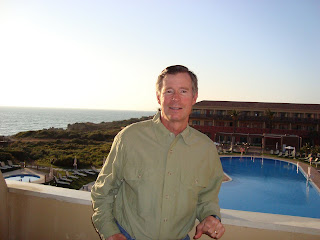Since returning to France in early April, we went into Paris for a weekend, spent 3 days in Brugge, and travelled through southern Portugal and Spain for 10 days.

Luxembourg gardens the day before Easter. We had dinner with our friend, Catherine, that evening, then went to a Gregorian Mass on Easter Sunday.
Brugge

In Brugge, a very pretty small town with canals and winding streets in northern Belgium
Portugal
 Overlooking Sintra, a very historic town with Moorish influences, perched on the side of a mountain to the west of Lisbon
Overlooking Sintra, a very historic town with Moorish influences, perched on the side of a mountain to the west of Lisbon
At a cafe in Sintra Sintra
Sintra
 As we left Sintra, we headed west to Cabo de Roca, the western-most point in Portugal and in Europe
As we left Sintra, we headed west to Cabo de Roca, the western-most point in Portugal and in Europe
 Next, we headed south toward the Algarve coast. This is a great restaurant in southern Portugal, nestled on a cove on the beach. You picked your own fresh fish from their catch of the day, and it was then prepared for you. Great Sangria made with sparkling white wine, too.
Next, we headed south toward the Algarve coast. This is a great restaurant in southern Portugal, nestled on a cove on the beach. You picked your own fresh fish from their catch of the day, and it was then prepared for you. Great Sangria made with sparkling white wine, too.

A beach on the Algarve coast near our hotel in southern Portugal. The beaches were very pretty, but the area was quite overdeveloped generally, with no discernible planning or control.
Spain
 Our favorite beach near our hotel in southern Spain on the Atlantic coast, near Conil de la Frontera
Our favorite beach near our hotel in southern Spain on the Atlantic coast, near Conil de la Frontera
 On the deck of our hotel room in Spain
On the deck of our hotel room in Spain We took a drive east to the Mediterranean Sea and the Rock of Gibraltar (in the background)
We took a drive east to the Mediterranean Sea and the Rock of Gibraltar (in the background)

We had lunch in this lovely hillside town, Vejer de la Frontera, in southern Spain

Back to Portugal
 Sintra
Sintra As we left Sintra, we headed west to Cabo de Roca, the western-most point in Portugal and in Europe
As we left Sintra, we headed west to Cabo de Roca, the western-most point in Portugal and in Europe Next, we headed south toward the Algarve coast. This is a great restaurant in southern Portugal, nestled on a cove on the beach. You picked your own fresh fish from their catch of the day, and it was then prepared for you. Great Sangria made with sparkling white wine, too.
Next, we headed south toward the Algarve coast. This is a great restaurant in southern Portugal, nestled on a cove on the beach. You picked your own fresh fish from their catch of the day, and it was then prepared for you. Great Sangria made with sparkling white wine, too.
A beach on the Algarve coast near our hotel in southern Portugal. The beaches were very pretty, but the area was quite overdeveloped generally, with no discernible planning or control.
Spain
 Our favorite beach near our hotel in southern Spain on the Atlantic coast, near Conil de la Frontera
Our favorite beach near our hotel in southern Spain on the Atlantic coast, near Conil de la Frontera On the deck of our hotel room in Spain
On the deck of our hotel room in Spain We took a drive east to the Mediterranean Sea and the Rock of Gibraltar (in the background)
We took a drive east to the Mediterranean Sea and the Rock of Gibraltar (in the background)
We had lunch in this lovely hillside town, Vejer de la Frontera, in southern Spain

Back to Portugal
On our way back to the Lisbon airport, we spent two nights in Evora, Portugal. Very beautiful city full of things to see. We had a great dinner of local wine, a tomato soup with bread and sausage, wild pig with potatoes, vegetables, and salad, dessert, and port wine, for $30 euros. We thought is must have been a mistake.

After dinner in Evora.









 Sledding across the street from our house with my sister Mary and brother Paul in mid-February
Sledding across the street from our house with my sister Mary and brother Paul in mid-February









